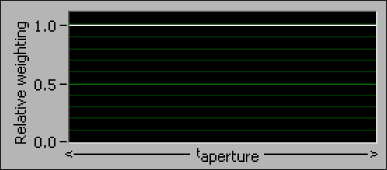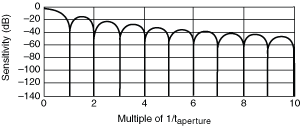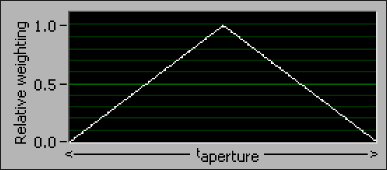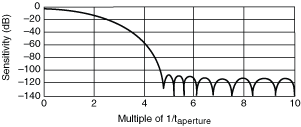DC Noise Rejection
DC noise rejection is a configurable noise reduction feature available for NI 4065 and NI 4070/4071/4072 DC measurements. Each DC reading the NI 4070/4071/4072 returns is actually an average of multiple high-speed samples. By adjusting the relative weighting of those samples, you can adjust the sensitivity to different interfering frequencies. The NI 4070/4071/4072 offers three different modes: normal, second-order, and high-order.
 |
Note The NI 4065 does not support high-order. |
Refer to the following table for a list of the differences between the three modes:
| DC Noise Rejection Setting | Lowest Frequency for Noise Rejection | High-Frequency Noise Rejection |
|---|---|---|
| Normal | 1/taperture | Good |
| Second-Order | 2/taperture | Better |
| High-Order | 4/taperture | Best |
Refer to the Aperture Time table for the default aperture times and DC noise rejection settings used by the DMM.
Normal
When you select normal DC noise rejection, the NI 4065 and NI 4070/4071/4072 weight all samples equally. This feature emulates the behavior of most traditional DMMs, providing good rejection of frequencies at multiples of f0, where f0 = 1/taperture. The following figure shows normal weighting, where all samples are weighted equally, and the resulting noise rejection as a function of frequency. Notice that you can obtain good rejection only very near multiples of f0. To get the fastest possible readings that give you some powerline noise rejection, set the aperture to the powerline period, such as 16.667 msec for a 60 Hz powerline frequency, and set the DC noise rejection to normal.


Second-Order
Second-order DC noise rejection applies a triangular weighting to the measurement samples, as shown in the following figure. In second-order DC noise rejection, the samples taken in the middle of the aperture time are weighted more than samples taken at the beginning and the end of the measurement.


Notice that you can obtain very good rejection near even multiples of f0 and that rejection increases more rapidly with frequency than with normal sample weighting. Also notice that the response notches are wider than they are with normal weighting, resulting in less sensitivity to slight variations in noise frequency. Use second-order DC noise rejection if you need better powerline noise rejection than you can get with normal DC noise rejection, but cannot afford to read slowly enough to take advantage of high-order noise rejection. For example, you could set the aperture to 33.333 msec for a 60 Hz powerline frequency.
High-Order
The following figure shows high-order sample weighting and its resulting noise rejection as a function of frequency:


 |
Note The NI 4065 does not support high-order. |
Notice that noise rejection is good starting at around four times f0 and is excellent above about 4.5 times f0. Sensitivity to noise at any frequency above 4.6 times f0 almost does not exist. An NI 4070/4071/4072, using high-order DC noise rejection with a 100 msec aperture (10 readings/sec), can deliver full 6½ digit accuracy with over 1 V of interfering powerline noise on the 10 V range at any frequency above 46 Hz.
The small tradeoff to using the higher-order filters is that to obtain powerline rejection, you must increase the measurement aperture by 2x (for second-order) or 4x (for high-order) versus that required for the normal setting. The increase in aperture time is typically minimal given the reduction in the interfering signal.